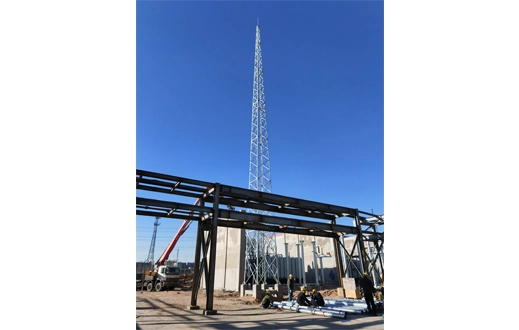The installation process of the 4 legs angular steel tower should be carried out strictly in accordance with the design drawings and installation process to ensure the quality of installation. The vertical tilt of the center of the tower body shall not be greater than 1/1000 of the tower height, and the tower torsion angle shall not be greater than ±1 degree. Lightning protection measures should be considered for the tower body, and the protection range includes microwave antennas and communication rooms. A lightning rod should be installed on the top of the tower, and the room and the tower share a grounding system. As one of telecom tower types, the surface of the angle steel tower should be treated with anti-corrosion to increase its service life in harsh environments. Except for the foundation skeleton and the components buried in the concrete, all components are treated with hot-dip galvanizing for anti-corrosion, and the thickness of the galvanizing layer should meet the standard requirements.
4-leg angle steel towers are the backbone of modern telecom infrastructure, offering unmatched stability and cost-efficiency. Compared to monopoles or lattice towers, their quadrilateral base design distributes load evenly, making them ideal for high-capacity 5G antennas and extreme weather conditions. Key benefits include:
Superior Wind Resistance: The 4-leg structure reduces sway, minimizing signal disruption in hurricanes or storms (tested up to 150 km/h wind speeds).
Scalability: Modular sections allow easy height adjustment (typically 30m to 60m) for terrain-specific coverage.
Low Maintenance Costs: Hot-dip galvanized steel resists corrosion for 25+ years, cutting long-term OPEX.
Quick Deployment: Prefabricated components slash installation time by 40% vs. concrete towers.
Regular maintenance ensures your 4-leg steel telecom towers survive decades of service. Follow these industry-approved practices:
1. Bi-Annual Structural Inspections
Check for bolt loosening (use torque wrenches to 200 Nm standard).
Scan for rust spots near welded joints—sand & repaint immediately.
2. Galvanization Integrity Checks
Measure zinc coating thickness (≥85 μm per ISO 1461); re-galvanize if under 50 μm.
3. Foundation Monitoring
Prevent tilting by clearing vegetation within 2 meters of base.
Test concrete foundations for cracks (>3mm width requires repair).
4. Lightning Protection
Verify lightning rod conductivity (<10 ohms resistance) before monsoon seasons.
Critical Warning: Ignoring corrosion in coastal areas can reduce lifespan by 60%—schedule salt-spray tests annually.
Angle Steel Tower: A Solid Pillar in the Field of Communication
